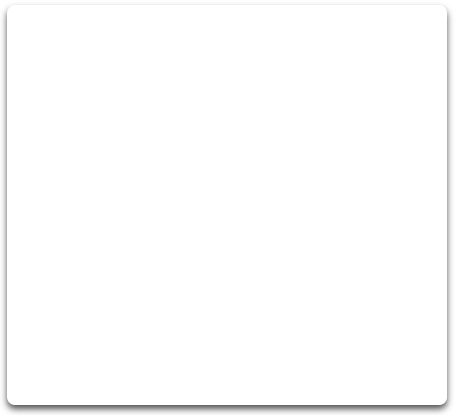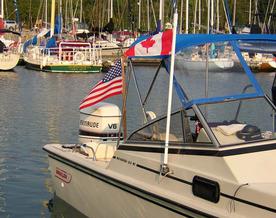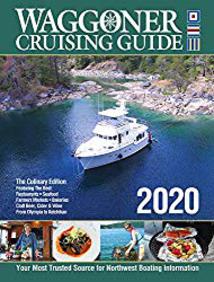Recreational Boating Information for the Northwest
Customs - Pacific Northwest
U.S. & Canada General Information
General Information for U.S. boaters:
Customs must be cleared whenever you cross the US - Canadian border. Until you have cleared customs, it is not legal to anchor, tie up to a dock or tie to a buoy unless you are there to check in. Other then docking assistance, only the vessel captain may leave the vessel until check-in is completed. Nothing may be off-loaded or loaded
and no person may board or permanently leave the vessel (except for Government officials) until the check-in is completed. If customs dock is closed, you may tie to customs dock but do not leave your vessel for any reason except an emergency. This apply for Canada & the U.S.
Pleasure boat vessels cross the boarder into Canadian or U.S. waters which do not touch ground are not required to clear customs. This is mainly for vessels sightseeing via waterway only. Some charter boats however are required to clear customs regardless.
Everyone crossing into Canada must have required citizenship documentation including children. Click here to see documents needed along with traveler program options to clear Canadian and U.S. Customs including NEXUS cards and other similar programs.
U.S. citizens entering Canada by boat must comply with requirements for the Canadian Pleasure Craft Operator Card. (PCOC). U.S. citizens are not required to carry a PCOC if their visit into Canada is 44 days or less. If your visit into Canada is longer then 44 consectuive days you must either have a Canadian PCOC or the equivalent operator card issued by your state of residence which most should have due to Washington State law. Visit the Transport Canada website for details.
Arrival into Canada:
Vessels must arrive at a marine telephone reporting site and immediately call the Canadian Telephone Reporting Centre at 1-888-226-7277. Canada Border Services Agency (CBSA) number is good 24hrs a day, 7 days a week. If reporting at a site, only the boat master may leave the vessel until authorization is given by the CBSA. Once cleared, you will be given a number with date/time of arrival location. (Note: it is suggested you keep clearance numbers for 12 months.) Once in Canada, vessels maybe subject to future inspections.
Information needed during check-in:
- ETA when calling with NEXUS or CANPASS.
- Names, DOB's, addresses, Citizenship Doc's for all traveling.
- Nexus number or CanPass if you have one.
- Boat registration numbers, owner of boat and boat name.
- Purpose for visit, destinations, length of stay and return date.
- A declaration of goods being imported including firearms and currency if greater than $10,000 dollars.
For required or expectable documentation needed to clear customs for adults, children and pets, click here.
Canadian Port of Entry:
- Bedwell - Poets Cove May to late September only - 8-5.
- Nanimo Port Authority On "E" dock - next to fuel dock
- Powell River-Discovery Harbour Call marina for details
- Sidney Marina, port of Customs on the end of "G" dock
- Sidney | Van Isle Marina Next to fuel dock.
- Vancouver | Coal Harbour TRS/M site Foot of Bute Street
- Vancouver | Fishermen's Wharf False Creek Public Dock TRS/M site
- Victoria Harbour Authority Between Wharf Street & float planes
- Victoria | Oak Bay Marina End of "F" dock | Fuel dock.
United States Port of entry:
- Anacortes | Cape Sante Call 360-293-2331 1 hour before arrival
- Friday Harbor On breakwater dock as you enter
- Roche Harbor Main outside dock as you approch
- Point Roberts Call for check-in location
- Port Townsend Schedule appointment prior to arrival
- Port Angeles Boat Haven Contact 24-hours prior to arriving
Arrivals into the United States:
Boats must arrive at a physical report site and the boat master must call the local CBP reporting telephone number. A customs dock will have a CBP phone or CBP officers on site. You may clear by phone at 1-800-562-5943 if boaters have nothing to declare and all on board have I-68 or NEXUS passes. Even with passes, you may be asked to report in for vessel inspection. Like Canada, you'll be given a clearance number which you should keep for 12 months.
United States Processing Fee:
Boats under 30 feet are not subject to processing fees. Boats 30 feet or more will need to purchase an annual processing fee when entering or returning to the U.S. This applies to U.S. and non-U.S. boats. I-68 and NEXUS pass holders are required to pay fee as well.
The processing fee can be paid at customs dock, over the phone or on-line. You can also order a sticker before you and return to the United States. Stickers are not available at customs locations but can be purchased on-line. Sticker / fee is good for one calendar year. Renewal notices for the next year are also mailed out. See DTOPS - Frequently Asked Questions about DTOPS page. You can also look into the Code of Federal Regulations: 19 CFR 24.22 for detailed information.
Food and Beverage Guideline / Restrictions:
Entering Canada or the United States
- You are allowed to bring in 24-12 oz. cans or bottles of beer or 40 oz liquor or 1.5 liters of wine - per person.
- 1 carton of Cigarettes or 50 cigars.
- Dairy products - less then 44 lbs.
- Meat - less then 44 lbs.
- Chicken - less then 22 lbs
- Fish - up to 20 kilograms per person
- Potatoes & Fruit - most prohibited
- Pet food generally ok if from the U.S. (no lamb or goat)
- No fresh tropical fruits or vegetables
- No corn on the cob, regarless of origin
- Avoid flowers, purchase in-country
Click here for more details on restrictions. Keep in mind restrictions change all the time. Even if you feel you're in compliance, don't be shocked if customs officers discard food or beverages.
A general rule when returning back to the United States, food and beverage restrictions are pretty much the same as entering Canada. To keep it simple, many recommend consuming any food and beverages purchased in Canada before returning to the U.S. On that same note, when traveling to Canada, keep a lite inventory of groceries on board...a good grocery trip after clearing customs can reduce many headaches for those long trips into the Gulf Islands and beyond.
Courtesy Flag | Host Country:
Standard flag etiquette suggests a vessel should fly the Canadian flag when entering Canadian waters. The host or foreign courtesy flag should be flown alone or separate from U.S. flag if displayed. Common placement is on the bow, mast or VHF antenna. It is also recommended you do not fly a courtesy flag after you have returned to U.S. waters. It is not intended to be used as a badge of accomplishment for having cruised to another country.
Quick Links:
- Requirements for private boaters
- Entering the U.S. by boat
Canadian Border Open to US Travelers:
If you plan on crossing the border into Canada you will need a few things:
> You have to be fully vaccinated (meaning two weeks after you got your final dose.) *Approved COVID-19 vaccines in Canada are Pfizer, Moderna, Astra Zeneca, and Johnson & Johnson.
> You need to submit some mandatory information through a Canadian border patrol app called ArriveCan.
> You have to live in the United States and travel to Canada from the United States.
> Be asymptomatic of all COVID symptoms.
> A negative COVID-19 test, even if you are fully vaccinated. It has to be a PCR test, rapid tests are not accepted by Canadian officials.







